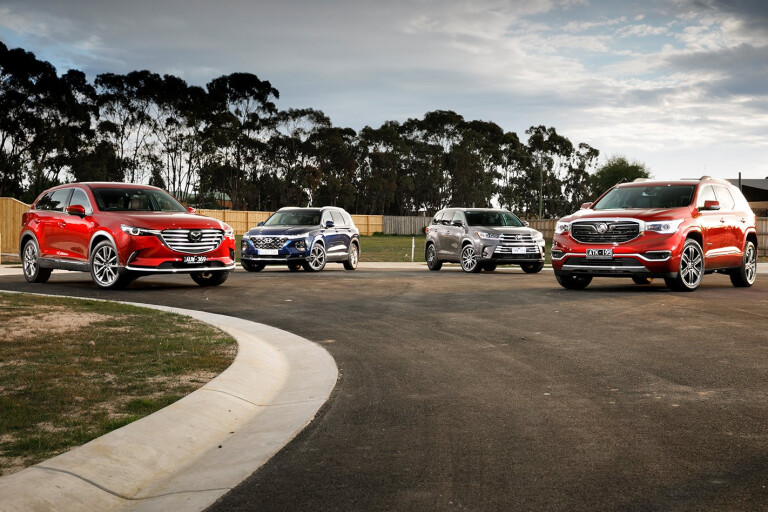
SEVENTY years ago, to the very day this issue hit the stands, a nervous General Motors unveiled the first Holden, a cream 48/215 sedan.
Based on a rejected wartime Chevrolet proposal out of Detroit, it was exactly what our car-starved nation craved.

Of course, the ‘FX’ and every one of its 31 locally manufactured successors have since woven themselves into our social fabric, but today, post factory shutdown with only imports from Thailand, Germany, Poland, England, Mexico and Korea to rely upon, ‘Australia’s Own’ is stumbling and our car-saturated country no longer cares.
Now, with the past a cross for the brand to bear, a worried Holden is once more looking to the US to find its way, with what many may be surprised to learn is the company’s first-ever full-sized seven-seater SUV.
Is the Acadia from Tennessee the crossover that the brand must bear to survive? Can America make Holden great again?
To find out, we’re fielding the $67,490 flagship LTZ-V all-wheel drive against a trio of its similarly monocoque-bodied AWD adversaries – in ascending order of popularity, the Hyundai Santa Fe, Mazda CX-9 and Toyota Kluger.
We’re talking proper range-toppers across all four, too, with leather, sunroof (dual panel in Acadia and panoramic in Santa Fe), electric tailgate, powered, heated and ventilated front seats with driver’s memory, surround-view cameras, tri-zone climate control, keyless entry/start, sat-nav, digital radio, premium audio and driver-assist safety tech including AEB, alerts for collision, lane-departure, blind spots and rear cross-traffic scenarios, adaptive cruise and auto high beams all included.
2018 Holden Acadia launch review
Metallic paint and – in the Hyundai – fancy beige/brown interior hues are the only options on test. Little wonder Holden reckons disenfranchised Statesman/Caprice and Ford Territory fans are in its marketers’ crosshairs.
Besides tough, bluff, GMC pick-up truck-like blokey good looks, the Acadia LTZ-V is unique with the very car-like inclusion of adaptive dampers, paired with the standard 20-inch alloys, a trailer-hitch camera view, haptic seat vibration alerts when danger encroaches and a nine-speed auto for its LGX High Feature 3.6-litre V6, while sharing with Santa Fe inductive smartphone charging and a pre-exit reminder to the driver to check the rear seats for kids.
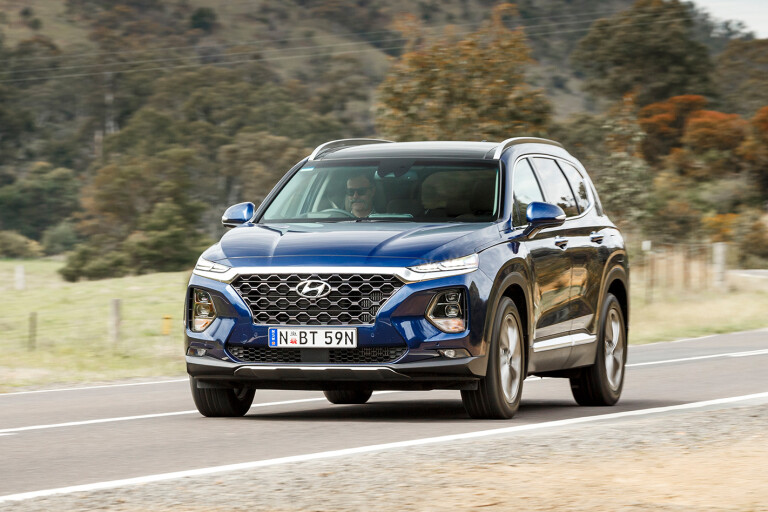
The Hyundai, represented by the $60,500 Highlander CRDi, is the cheapest on test, highlighting value pricing that helped it score a slim victory in our recent stoush against three other diesel-powered seven-seaters. Huh? Diesel? Frustratingly, a petrol-six alternative is not offered in high-end variants, so the trusty, torquey old 2.2-litre four-cylinder turbo oil-burner it is, mated to a brand-spanking in-house eight-speed auto. This probably partly explains why this completely redesigned TM series out of Korea hasn’t yet blitzed the sales charts since landing in July, though heavy-handed styling after the handsomely slick DM predecessor may also be to blame.
Alone with an ‘Auto Link Premium’ app that – among other things – brings remote-controlled engine-start/stop, locking, hazards, horn, climate and defroster to the driver’s fingertips, the Highlander also matches the Toyota and Mazda by brandishing side window blinds, and the latter brand with a head-up display and heated wheel/outboard rear seating. Swish!
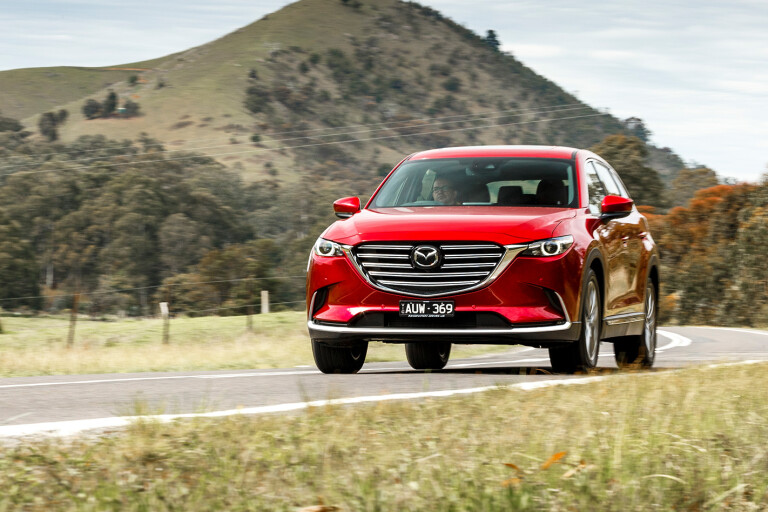
Released in September, the revised MY19 CX-9 – in glitzy Azami LE guise from $66,490 – is more than just the brand’s long-overdue Apple CarPlay/Android Auto debut (BT-50 aside), with improved (fixed-rate) dampers, beefier steering components, sturdier engine mounts and a thicker headlining, joining Audi-esque frameless interior mirrors, an overhead storage console and hand-finished leather, wood and aluminium inserts. Lush. It’s the second update the COTY-winning TC series has received since arriving from Japan in July 2016.
Older still is this quartet’s bestseller, the Kluger. A mover-’n’-shaker across both sides of the Pacific (where, confusingly, it’s known as the Highlander – a name Hyundai has denied Toyota Oz permission to use for 15 years) ours is the Indiana-made Series II makeover, which surfaced in early 2017 with direct-injection for the gutsier 3.5-litre V6, an eight-speed auto and updated active safety.
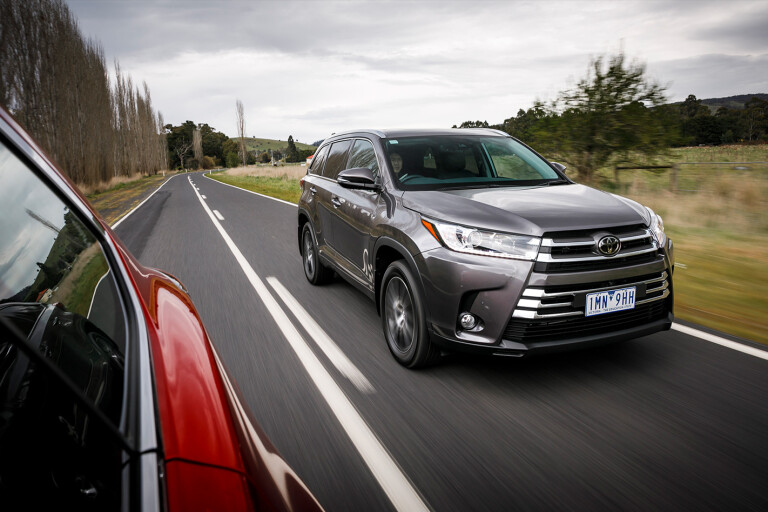
At nearly $10K per seat, our $69,246 Grande AWD’s only real USPs are a tailgate with separate-opening glass hatch (memories of Territory right there) and antiquated roof-mounted Blu-Ray player (perfect for watching Finding Nemo and The Wire box-set). Oh, and two fewer years of warranty, at only three years. Boo!
Still, it’s plain to see why the square-jawed Kluger is such a showroom draw. Immense in every dimension, the Grande grants loads of space for five adults and will happily accommodate an extra two in the simple-to-access third row. Operation-friendly controls, huge (analogue-only) dials and a humongous central bin further aid family-focused travel.
However, extended stints on the fat, flat seats reveal support shortfalls, cheapo monotone hues abound and hard plastics offer neither surprise nor delight in something so expensive. And don’t bang your noggin on that low-hanging DVD player, either.
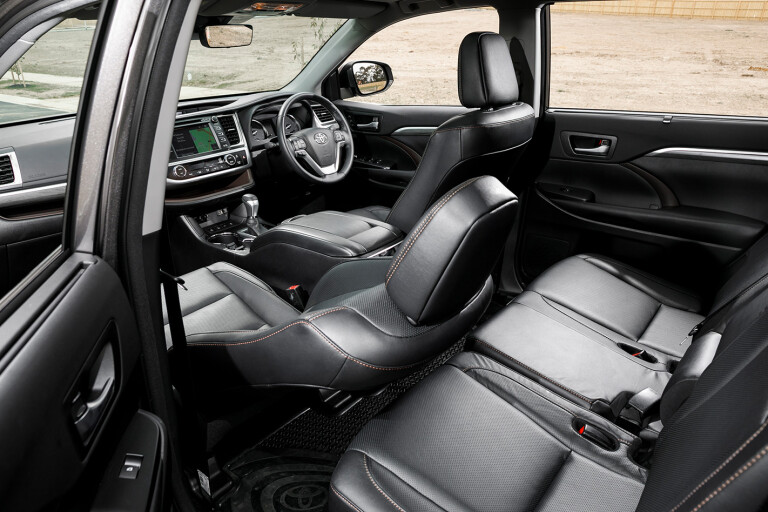
If only Toyota hired Hyundai’s cabin curators, with their playful yet proficient deployment of colours and textures, which significantly lift the Highlander’s ambience. Tighter physical dimensions dictate there's less space, but third-row access is brilliant thanks to a novel one-touch seat fold/slide mechanism. Throw in well-padded pews and the Hyundai’s classy, inviting interior can still accommodate seven in comparative comfort.
If you happen to be sat right in the Santa Fe’s rear then vision is hampered by the rising window line (though it’s way better than before) and tall centre-row backrests, but there’s multi-speed fan control as well as the lights, cupholders and 12-volt outlets that the others also provide. Too bad clambering in/out is tricky due to narrow apertures. Note that none boast the satisfaction of motorised push-button second-row backrest releases.
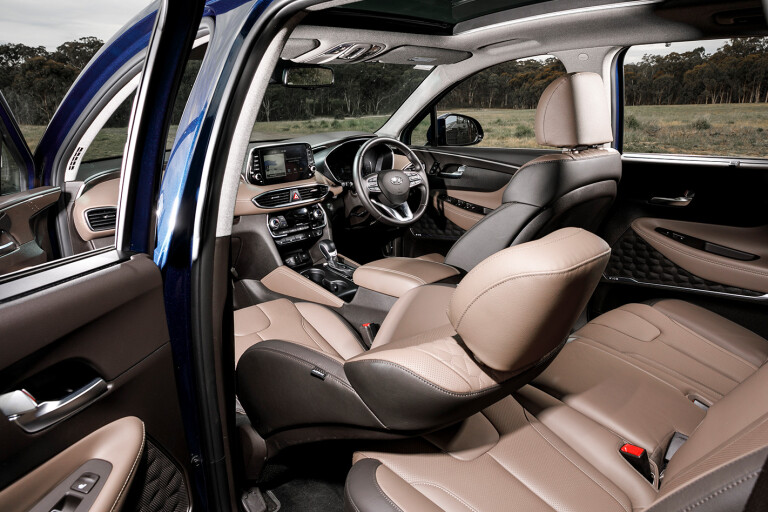
There’s almost dull uniformity across all four SUVs as far as middle-row amenities including storage, ventilation and USB access are concerned, with varying but overall more-than-sufficient leg, knee, head and shoulder space on offer – even in the compact Highlander. People are sat somewhat higher than those up front, especially in the stadium-esque Mazda, though elevation amounts vary.
Greater differences lurk up front, with the Hyundai clearly gaining inspiration from the CX-9 for design and layout, if not quite in execution. Both deliver a low cowl, snug driving position, wide centre console, prominently perched touchscreen, sporty instrumentation and supportive seating that provide an inclusive cockpit experience.
Where the Highlander stumbles yet the Azami LE soars is in the details; there’s a sheen of luxury in the former that is betrayed by budget plastics and jarringly irregular graphics, while the latter adheres to doggedly consistent, lofty stylised standards throughout. It’s the difference between tacked-on and built-in.

Yes, the CX-9 lacks third-row face-level outlets, but the middle-row’s vents do effectively disperse air; seat comfort remains a priority throughout, and no cabin is as quiet or classy. At five metres, the Mazda is nearly limo-like in length, and so provides the necessary space and practicality, yet does so with moxie and panache. The Azami LE feels its sticker price.
If the CX-9 is the massive SUV that doesn’t seem it, the Acadia somehow is the opposite, and a peculiarly, charmingly/irritatingly American take on what constitutes a seven-seater at that. While the Kluger feels large and utilitarian, the Santa Fe stylised and spec-laden and the CX-9 cool and cultivated, the Holden nee-GMC manages to meld elements of all three, in a long, wide and boxy wagon that Canyonero-driving Marge Simpson might revel in.
Agreeable seating (especially the middle and rearmost rows, which are cushy for hefty derrieres and low-set for larger folk), a chunky (if overly plasticky and a tad greasy) dash with ZB Commodore VXR-like analogue/digital instrument combos and suave new multimedia interface, and laughably generous storage throughout will quickly win friends, but please brace for iffy trim quality, sloppy finishes, clumsy thumb-actuated tip-shifter and a vague drive-mode selector.
Infuriatingly, the flat-floored Acadia’s refreshingly airy, roomy cabin comes achingly close to ideal until you realise that GM didn’t bother switching the middle row for RHD, so kerb-side occupants must tip and slide the larger portion of the bench to squeeze through. Fail.
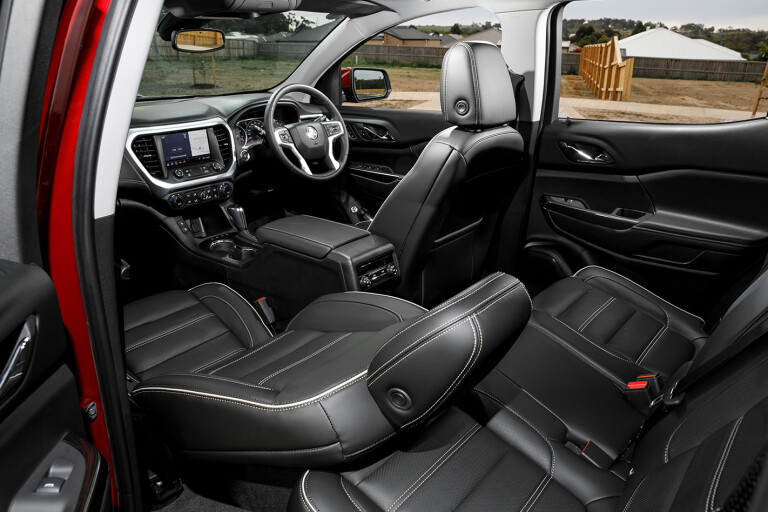
Despite the voluminosity, entry/egress to the third row is inexplicably tight. The Yank is also vocal and occasionally even vibey back there, too.
Some of that noise can be blamed on the brawny Acadia’s 231kW/367Nm 3.6-litre V6, which makes the most of its Aussie-tuned nine-speed auto to deliver rousing as well as rapid performance. Brisk off the line, the LTZ-V is quickest in every increment, and blitzes the others in rolling acceleration, requiring just 4.7sec to surge from 80-120km/h – nearly a second clear of the next-best.
That the hot-rod of the quartet also returned an impressive 10.0L/100km reflects the efficiency of the powertrain calibration. That was only a litre adrift of the Santa Fe diesel, which admittedly was throttled mercilessly to keep up with the speedy petrol pack. Battling gusts at Heathcote, the Hyundai fell short of the 9.5sec 0-100km/h we managed a few weeks earlier. That said, in isolation, the 147kW/440Nm 2.2 CRDi’s refinement is remarkable, and once in the torque band in real-world scenarios, provides ample oomph for eager dispatch.

As with every current Kluger we’ve tested, our Grande’s performance proved both strident as it strove effortlessly to 100km/h (in 8.0sec flat) and muscular in the mid-range, remaining within half a second of the hard-charging Acadia in the 400-metre sprint at 15.8sec. The revised 218kW/350Nm 3.5-litre V6 is also sonorously smooth and reasonably parsimonious to boot, using 10.4L/100km. Another good showing from the Toyota in its twilight years.
The Mazda with its 170kW/420Nm 2.5-litre four-pot turbo, meanwhile, always felt quick, strong and reactive to throttle inputs away from the track, despite its failure to breach the 8.0sec 0-100km/h mark on our blustery drag strip. Across 400m it was just 0.1sec shy of the Kluger, revealing the rich torque band at low revs, that translates to quite vigorous, lusty reflexes when called upon.
Again, in its natural environment, those six forward ratios make the most of the turbo’s outputs to really push the CX-9 along, while kickdown is instantaneous. That the Holden recorded slightly better fuel economy did shock, however, though the Azami LE did beat our previous efforts.

Where the Mazda really slays is in its dynamic character, with the group’s meatiest and most involving steering, which delivers outstandingly lively and tactile handling for an SUV of this size and mass, as well as predictable, four-square grip.
And it’s not just for the keener drivers either, for even on 20-inch alloys, the recently fettled suspension’s inherent suppleness is obvious, ironing out irregularities while still providing sufficient damping over more serious stuff. The ride does err on the firm side, but the compromise between comfort, control and quietness puts the Azami LE in a league above most competitors. At any price point.
Holden revealed that, in the LTZ-V, the helm’s feel has been tuned for lightness but is still weightier than the US GMC set-up, and that’s probably fine for the vast majority of Acadia buyers.
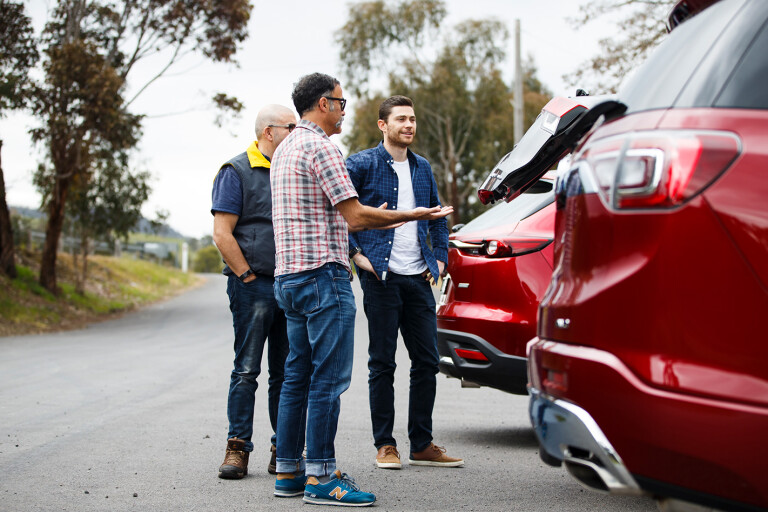
For us, though, even in the heavier Sport mode, we wanted more heft, though turn-in is certainly crisp and measured enough, with levels of poise and control for a two-tonne SUV that enthusiasts can actually revel in, especially when pressing on. Even more so over gravel, in fact, where the Holden really steps up.
Also on 20s, the Acadia’s electronic dampers make a huge difference, offering a softness over larger hits that isn’t matched here. But whether the Holden brings a palpably better ride than the CX-9 is debatable; in comfort mode the LTZ-V displays less dynamic discipline than the Mazda, while in Sport the busier suspension is less absorbent. And it’s also noisier overall. Again, the Hiroshima machine’s honed consistency pays dividends.
The Santa Fe, too, brings some unexpectedly sporty dynamics to the table, shrinking around the driver with the series’ newfound agility, tautness and assurance, backed up by stable and relaxed gait in
most circumstances.
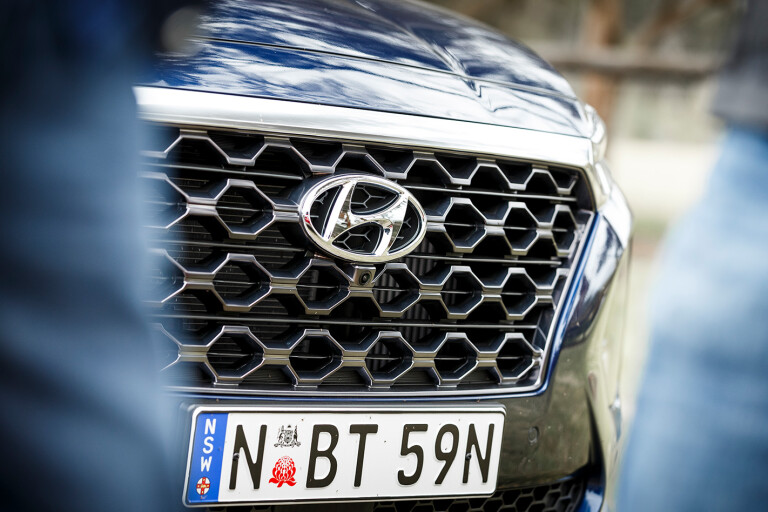
On the other hand, there’s none of the CX-9’s natural driver engagement from the steering, while the chassis can feel too stiffly tuned, with limited wheel travel when roads turn rough, accompanied by discernible lateral as well as vertical body movement over nastier bitumen.
Lastly, there’s the Kluger. Capable and even commanding across a variety of conditions, it offers up surprisingly contained and surefooted handling and steering characteristics, and a wheel that’s also reassuringly isolated from any kickback. It's too remote for our tastes, though, while the ride never really feels settled, telegraphing niggling irregularities with annoying regularity. The Toyota is also prone to vibration and pitching, which seals it as the least dynamically disciplined of the foursome.

The Grande, then, is a big, reliable, hardy and no-nonsense seven-seater with plenty of poke – those 2017 updates weren’t in vain. But it’s also an expensive and dated bus that feels out of its depth here.
In isolation, the Highlander is a massive leap forward for the Santa Fe, bringing newfound packaging and presentation appeal to go with its handling alacrity. There’s no missing that comparatively low price either. A deserving winner against other diesel rivals, in this company, the Hyundai lacks the consistency, polish and appeal of the CX-9, as well as the character, composure and completeness of the Acadia.
Ultimately, the Mazda CX-9 uses its smarts most effectively to outmanoeuvre its rivals. Cohesive, confident and alluring, the Azami LE feels special where the others may merely seem capable. We’re as proud as ever of our 2017 COTY call.
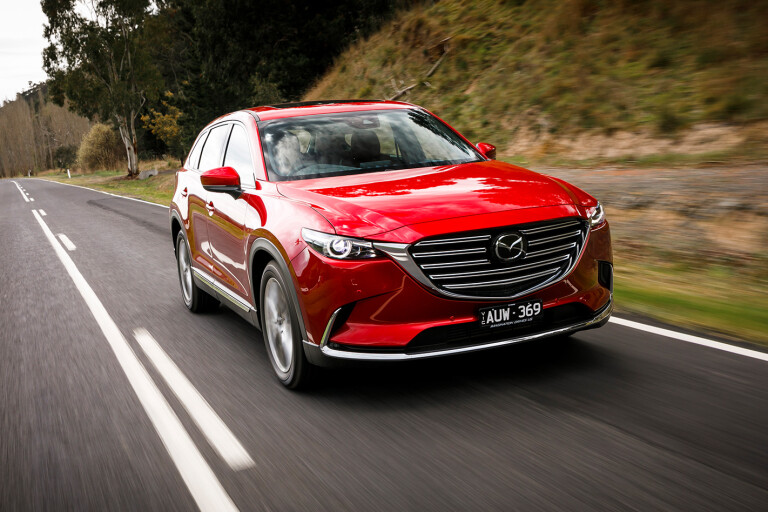
But, boy, we’d not hesitate recommending the Acadia LTZ-V. Attitude, personality, specification, packaging, performance and efficiency are highlights. It’s a strong shot at the top of the class – one that falls just short of snatching victory from the high-flying CX-9.
Unashamedly American as it is, the Acadia could be the model to make Australians crave a Holden again.

COMMENTS